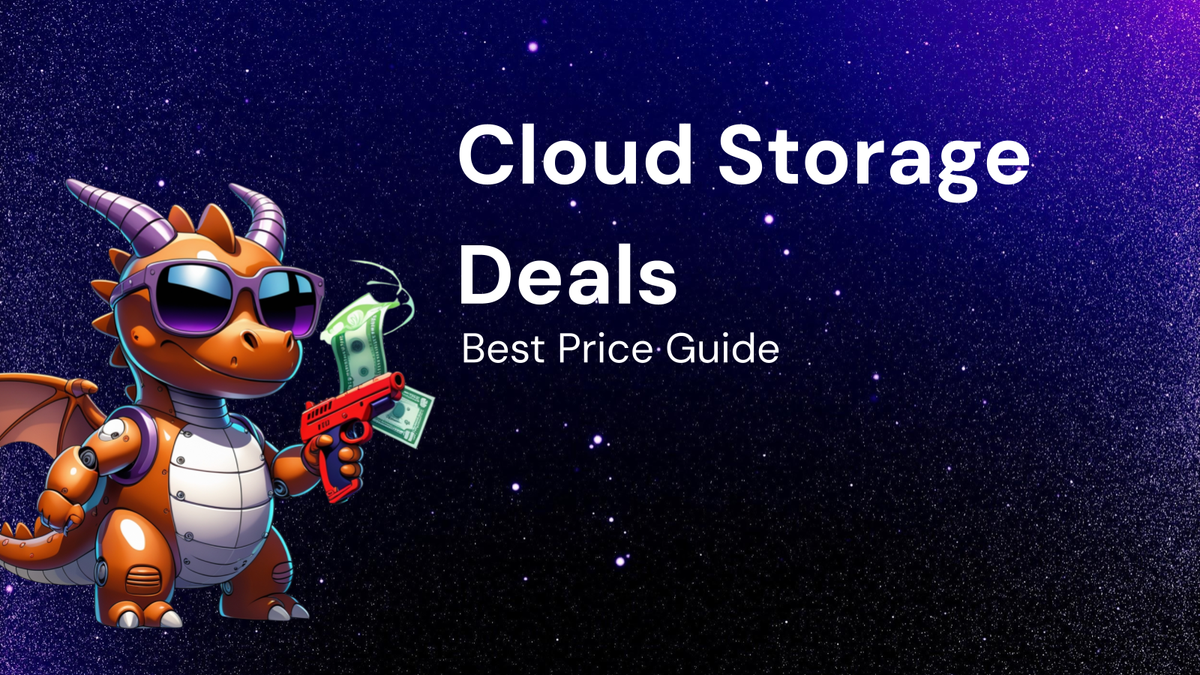cloud storage Deals Explained – Best Time To Buy + best price Guide

Cloud Storage Deals Explained – Best Time To Buy + Best Price Guide
Cloud storage has become an indispensable tool for individuals and businesses alike. It offers a convenient, secure, and accessible way to store and manage data, eliminating the need for physical storage devices and providing peace of mind against data loss. However, navigating the cloud storage landscape can be overwhelming, especially when it comes to finding the best deals and understanding the pricing structures. This guide aims to demystify the world of cloud storage deals, providing you with the information you need to make informed decisions and secure the best possible price.
Why Cloud Storage is Essential in Today's World
Before diving into the specifics of deals and pricing, it's crucial to understand why cloud storage has become so vital:
- Accessibility: Access your files from anywhere in the world with an internet connection.
- Security: Reputable cloud providers implement robust security measures to protect your data.
- Collaboration: Share files and collaborate on projects with ease.
- Scalability: Easily increase or decrease storage capacity as your needs evolve.
- Data Backup and Recovery: Protect your data against hardware failures, natural disasters, and human error.
- Cost-Effectiveness: Often more affordable than maintaining physical storage infrastructure, especially for businesses.
Understanding Different Types of Cloud Storage
Not all cloud storage is created equal. Understanding the different types can help you choose the best solution for your specific needs:
- Personal Cloud Storage: Designed for individual users to store photos, videos, documents, and other personal files. Examples include Google Drive, Dropbox, iCloud, and OneDrive.
- Business Cloud Storage: Tailored for businesses, offering features like collaboration tools, user management, and advanced security. Examples include Google Workspace, Microsoft 365, Dropbox Business, and Box.
- Object Storage: A highly scalable and cost-effective solution for storing unstructured data like images, videos, and backups. Examples include Amazon S3, Google Cloud Storage, and Azure Blob Storage.
- File Storage: Provides a traditional file system interface, allowing you to organize files into folders and directories. Examples include Amazon EFS, Google Cloud Filestore, and Azure Files.
- Block Storage: Stores data in fixed-size blocks, offering high performance for applications that require low latency. Examples include Amazon EBS, Google Persistent Disk, and Azure Disk Storage.
Decoding Cloud Storage Pricing Models
Cloud storage providers typically offer a variety of pricing plans based on factors such as storage capacity, features, and usage. Here's a breakdown of common pricing models:
- Pay-as-you-go: You only pay for the storage you use, making it ideal for fluctuating storage needs.
- Subscription-based: You pay a fixed monthly or annual fee for a specific amount of storage and features. This is often the most cost-effective option for consistent storage needs.
- Tiered Pricing: Storage is priced in tiers, with lower prices for higher storage volumes.
- Usage-based Pricing: You pay for the amount of data transferred in and out of the cloud (bandwidth).
- Free Tier: Many providers offer a free tier with limited storage capacity, allowing you to test the service before committing to a paid plan.
Key Pricing Considerations:
- Storage Capacity: The amount of storage space you need.
- Bandwidth: The amount of data you upload and download.
- Number of Users: The number of users who will access the storage.
- Features: The specific features you require, such as collaboration tools, security features, and data recovery options.
- Region: The geographical region where your data is stored, as prices may vary.
- Support: The level of support you need from the provider.
Identifying the Best Time to Buy Cloud Storage
Timing is everything, even when it comes to cloud storage. Understanding seasonal trends, promotional periods, and other factors can help you snag the best deals:
- Black Friday and Cyber Monday: Many cloud storage providers offer significant discounts during these major shopping events.
- End-of-Year Sales: Look for deals in December as providers try to meet their sales targets.
- Back-to-School Promotions: Some providers offer discounts for students and educators during the back-to-school season.
- Anniversary Sales: Keep an eye out for anniversary sales or special promotions from individual providers.
- New Product Launches: Providers often offer introductory discounts when launching new products or features.
- Monitor Competitor Pricing: Cloud storage pricing is competitive. Stay informed about deals offered by different providers.
- Consider Long-Term Commitments: Many providers offer discounts for annual or multi-year subscriptions.
A Comprehensive Guide to Finding the Best Cloud Storage Deals
Here's a step-by-step guide to help you find the best cloud storage deals:
1. Assess Your Storage Needs:
- Determine the Amount of Storage You Need: Estimate the total amount of data you need to store now and in the future. Consider factors like the size of your files, the number of files you need to store, and your data growth rate.
- Identify Your Essential Features: What features are most important to you? Do you need collaboration tools, advanced security features, or specific integrations with other applications?
- Consider Your Budget: How much are you willing to spend on cloud storage? Set a realistic budget and stick to it.
2. Research and Compare Cloud Storage Providers:
- Read Reviews and Ratings: Check out online reviews and ratings from reputable sources to get an idea of the pros and cons of different providers.
- Compare Pricing Plans: Carefully compare the pricing plans of different providers, taking into account storage capacity, bandwidth, features, and other factors.
- Look for Free Trials or Free Tiers: Take advantage of free trials or free tiers to test out the service before committing to a paid plan.
- Evaluate Security Measures: Make sure the provider implements robust security measures to protect your data, such as encryption, two-factor authentication, and regular security audits.
- Check for Data Recovery Options: Ensure the provider offers data recovery options in case of data loss or corruption.
- Assess Customer Support: Evaluate the quality of customer support offered by the provider. Do they offer 24/7 support? How responsive are they to inquiries?
3. Leverage Online Resources and Comparison Tools:
- Use Cloud Storage Comparison Websites: Several websites allow you to compare cloud storage providers side-by-side based on factors like pricing, features, and security.
- Read Tech Blogs and Articles: Stay informed about the latest cloud storage trends and deals by reading tech blogs and articles.
- Follow Cloud Storage Providers on Social Media: Follow your favorite cloud storage providers on social media to stay up-to-date on their latest promotions and announcements.
4. Negotiate with Cloud Storage Providers (Especially for Businesses):
- Contact Sales Representatives: Don't be afraid to contact sales representatives and ask for a better deal, especially if you're a business with significant storage needs.
- Leverage Competitor Pricing: Use competitor pricing as leverage to negotiate a lower price.
- Consider Long-Term Commitments: Offer to commit to a long-term contract in exchange for a discount.
- Bundle Services: If you need other services from the provider, such as cloud computing or data analytics, consider bundling them together to get a better deal.
5. Be Aware of Hidden Costs and Fine Print:
- Read the Terms of Service Carefully: Before signing up for a cloud storage plan, carefully read the terms of service to understand the provider's policies on data storage, security, and usage.
- Watch Out for Hidden Fees: Be aware of potential hidden fees, such as overage charges, data transfer fees, and early termination fees.
- Understand Data Residency Requirements: If you have specific data residency requirements, make sure the provider can meet them.
- Consider Data Migration Costs: Factor in the cost of migrating your data to the cloud.
Top Cloud Storage Providers and Their Typical Deals
While specific deals fluctuate, here's an overview of some popular providers and the types of promotions they often run:
- Google Drive: Often bundled with Google Workspace, offering competitive pricing for individuals and businesses. Look for deals on storage upgrades and discounts on annual subscriptions.
- Dropbox: Known for its user-friendly interface and collaboration features. Keep an eye out for promotions on Dropbox Plus and Dropbox Business plans.
- Microsoft OneDrive: Integrated with Microsoft 365, providing seamless access to Office applications. Look for deals on OneDrive plans bundled with Microsoft 365 subscriptions.
- Amazon S3: A highly scalable and cost-effective object storage service. Ideal for businesses with large amounts of unstructured data. Pay-as-you-go pricing with volume discounts.
- Backblaze: Known for its unlimited backup plans. Offers competitive pricing for personal and business backups.
- pCloud: Offers lifetime plans, allowing you to pay once for permanent storage.
- Box: A business-focused cloud storage solution with robust security and collaboration features. Look for deals on enterprise plans.
Disclaimer: This information is for guidance only. Deals and pricing are subject to change by the individual providers. Always verify the current offers and terms directly with the provider.
Tips for Optimizing Your Cloud Storage Costs
Once you've found a good deal, you can further optimize your cloud storage costs with these tips:
- Regularly Review Your Storage Usage: Identify and delete unnecessary files to free up storage space.
- Compress Large Files: Compress large files before uploading them to the cloud.
- Use Data Deduplication: Take advantage of data deduplication features to eliminate duplicate files and reduce storage costs.
- Archive Old Data: Move infrequently accessed data to lower-cost storage tiers.
- Implement Data Lifecycle Management Policies: Define policies for automatically moving data to different storage tiers based on its age and usage.
- Monitor Bandwidth Usage: Track your bandwidth usage and identify any potential bottlenecks.
- Choose the Right Storage Tier: Select the appropriate storage tier based on your access frequency and performance requirements.
- Take Advantage of Reserved Instances: If you have predictable storage needs, consider purchasing reserved instances to save money.
Cloud Storage for Specific Needs: Tailoring Your Search
Different users have different priorities. Here's how to tailor your search based on specific needs:
- Photographers and Videographers: Look for providers with ample storage space, fast upload and download speeds, and robust security features. Consider options like SmugMug or specialized photo storage services.
- Businesses with Remote Teams: Prioritize collaboration tools, user management features, and strong security. Google Workspace, Microsoft 365, and Dropbox Business are good options.
- Individuals Backing Up Personal Data: Focus on affordability, ease of use, and reliable backup features. Backblaze and other backup-focused services are worth considering.
- Developers and IT Professionals: Look for providers with robust APIs, command-line tools, and integration with development platforms. Amazon S3, Google Cloud Storage, and Azure Blob Storage are popular choices.
The Future of Cloud Storage and What to Expect
The cloud storage landscape is constantly evolving. Here are some trends to watch out for:
- Increased Focus on Security and Privacy: With growing concerns about data breaches and privacy, cloud storage providers are investing heavily in security and privacy features.
- AI-Powered Cloud Storage: AI is being used to automate tasks like data classification, threat detection, and data optimization.
- Edge Computing Integration: Cloud storage is being integrated with edge computing to enable faster data processing and lower latency.
- Hybrid Cloud Solutions: More organizations are adopting hybrid cloud solutions that combine on-premises storage with cloud storage.
- Serverless Cloud Storage: Serverless computing is being applied to cloud storage, allowing developers to build applications without managing servers.
- Greater Emphasis on Sustainability: Cloud storage providers are increasingly focused on reducing their environmental impact through energy-efficient data centers and renewable energy sources.
Making the Right Choice for Your Cloud Storage Needs
Choosing the right cloud storage solution requires careful consideration of your specific needs, budget, and priorities. By following the tips and guidelines outlined in this article, you can navigate the cloud storage landscape with confidence and find the best possible deal. Remember to continuously evaluate your storage needs and adapt your strategy as your requirements evolve. Don't be afraid to experiment with different providers and features to find the perfect fit for your unique circumstances. The cloud storage market is dynamic and competitive, so taking the time to research and compare options will ultimately save you money and ensure that your data is safe, accessible, and well-managed.




